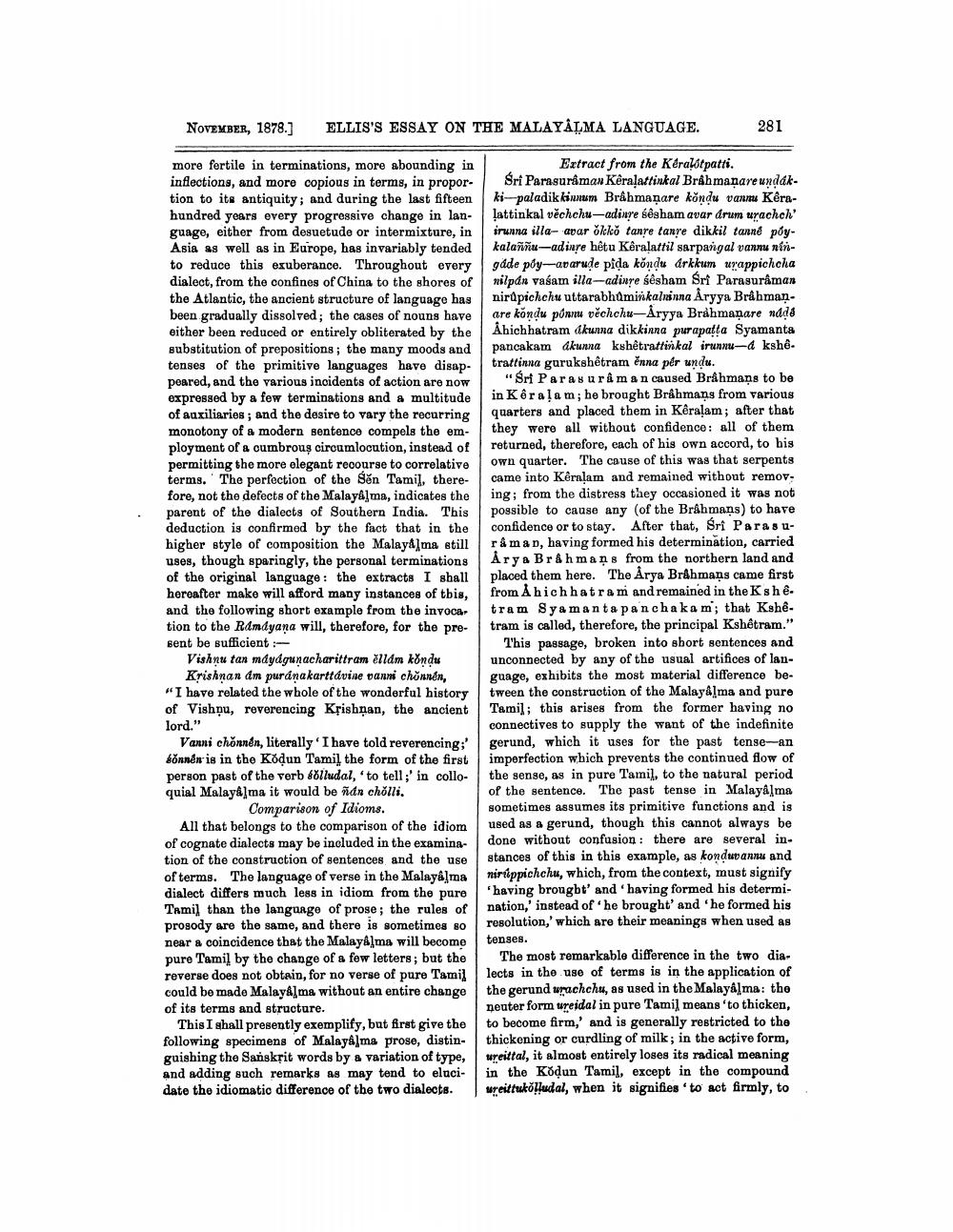________________
NOVEMBER, 1878.]
ELLIS'S ESSAY ON THE MALAYALMA LANGUAGE.
more fertile in terminations, more abounding in inflections, and more copious in terms, in proportion to its antiquity; and during the last fifteen hundred years every progressive change in language, either from desuetude or intermixture, in Asia as well as in Europe, has invariably tended to reduce this exuberance. Throughout every dialect, from the confines of China to the shores of the Atlantic, the ancient structure of language has been gradually dissolved; the cases of nouns have either been reduced or entirely obliterated by the substitution of prepositions; the many moods and tenses of the primitive languages have disappeared, and the various incidents of action are now expressed by a few terminations and a multitude of auxiliaries; and the desire to vary the recurring monotony of a modern sentence compels the employment of a cumbrous circumlocution, instead of permitting the more elegant recourse to correlative terms. The perfection of the Sen Tamil, therefore, not the defects of the Malayalma, indicates the parent of the dialects of Southern India. This deduction is confirmed by the fact that in the higher style of composition the Malayalma still uses, though sparingly, the personal terminations of the original language: the extracts I shall hereafter make will afford many instances of this, and the following short example from the invoca. tion to the Ramayana will, therefore, for the present be sufficient :
Vishnu tan máyágunacharittram ĕllám kondu Krishnan ám puránakarttavine vanni chonnen, "I have related the whole of the wonderful history of Vishnu, reverencing Krishnan, the ancient lord."
Vanni chonnén, literally 'I have told reverencing;' bonnen is in the Kōdun Tamil the form of the first person past of the verb éŏlludal, 'to tell;' in colloquial Malayalma it would be ñán cholli.
Comparison of Idioms.
All that belongs to the comparison of the idiom of cognate dialects may be included in the examination of the construction of sentences and the use
of terms. The language of verse in the Malayalma dialect differs much less in idiom from the pure Tamil than the language of prose; the rules of prosody are the same, and there is sometimes so near a coincidence that the Malayalma will become pure Tamil by the change of a few letters; but the reverse does not obtain, for no verse of pure Tamil could be made Malayalma without an entire change of its terms and structure.
This I shall presently exemplify, but first give the following specimens of Malayalma prose, distinguishing the Sanskrit words by a variation of type, and adding such remarks as may tend to elucidate the idiomatic difference of the two dialects.
281
Extract from the Kéralotpatti. Śri Parasuraman Kêralattinkal Brahmanare undákki-paladik kinnum Brahmaṇare kondu vannu Kêralattinkal věchchu-adinge sêsham avar árum uṛachch' irunna illa avar okko tanṛe tanṛe dikkil tanné póykalaññu-adinge hêtu Kêralattil sarpangal vannu ningáde poy-avarude piḍa kondu árkkum urappichcha nilpán vasam illa-adinre śêsham Sri Parasuraman nirapichchu uttarabhaminkalninna Åryya Brahmanare kondu pónu věchchu-Aryya Brahmaṇare nada Ahichhatram akunna dikkinna purapatta Syamanta pancakam akunna kshêtrattinkal irunnu-d kshê. trattinna gurukshetram enna pêr undu.
"Sri Parasurâ man caused Brâhmans to be in Kêralam; he brought Brâhmans from various quarters and placed them in Kêralam; after that they were all without confidence: all of them returned, therefore, each of his own accord, to his own quarter. The cause of this was that serpents came into Kêralam and remained without removing; from the distress they occasioned it was not possible to cause any (of the Brahmans) to have confidence or to stay. After that, Śri Paras uråman, having formed his determination, carried Arya Brahmans from the northern land and placed them here. The Arya Brâhmans came first from Ahichhatram and remained in the K s hê. tram Syamantapanchaka m; that Kshêtram is called, therefore, the principal Kshetram."
This passage, broken into short sentences and unconnected by any of the usual artifices of language, exhibits the most material difference between the construction of the Malayalma and pure Tamil; this arises from the former having no connectives to supply the want of the indefinite gerund, which it uses for the past tense-an imperfection which prevents the continued flow of the sense, as in pure Tamil, to the natural period of the sentence. The past tense in Malayâļma sometimes assumes its primitive functions and is used as a gerund, though this cannot always be done without confusion: there are several instances of this in this example, as konduvannu and nirúppichchu, which, from the context, must signify 'having brought' and 'having formed his determination,' instead of 'he brought' and 'he formed his resolution,' which are their meanings when used as tenses.
The most remarkable difference in the two dialects in the use of terms is in the application of the gerund urachchu, as used in the Malayalma: the neuter form ureidal in pure Tamil means 'to thicken, to become firm,' and is generally restricted to the thickening or curdling of milk; in the active form, ureittal, it almost entirely loses its radical meaning in the Kodun Tamil, except in the compound ureittukolludal, when it signifies to act firmly, to




